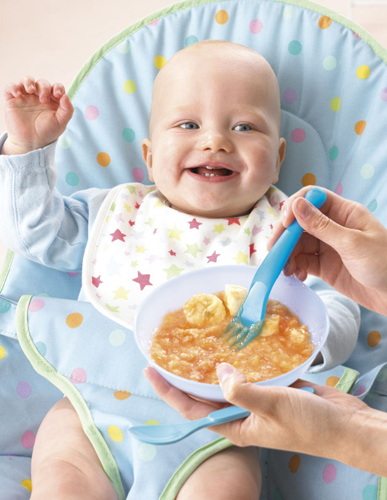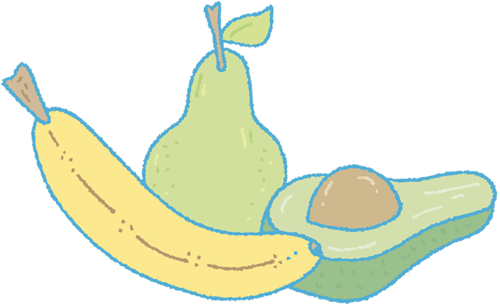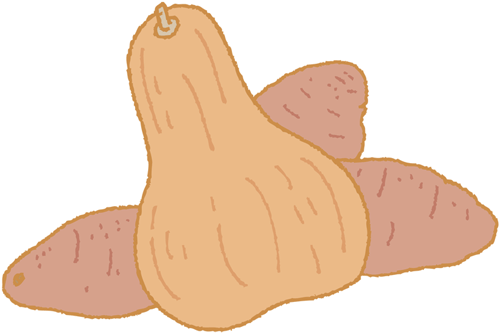|
Some babies find the transition to solid foods
easy, while others can be more resistant. Try to stick to a daily
routine, even if you are out and about, or on vacation. It’s not always
easy, but with a little ingenuity and a good thermos, you’ll soon overcome any problems.

| Q: |
My baby refuses the same foods over and over again; how can I tempt him to eat more foods?
| | A: |
Perseverance is the order of the day. Simply continue to offer
the “new” foods over and over again, until they become familiar to your
baby (see My baby likes only one type of food, and refuses everything else; any advice?).
You can try them in different combinations—for example, mixing spinach
with some apple purée or even a little Parmesan cheese and his normal
baby milk, adding apricots to sweet potato, and pear to peas. Once you
find one or two things you know he likes, you can use these as a base
for creating different blends.
Remember too that
many babies have quite sophisticated tastes. Baby food doesn’t have to
be bland, and your little one may enjoy trying exciting tastes that you
may not have considered, such as garlic or a touch of mild curry paste
in the cooking.
|
| Q: |
Can you recommend some combinations of vegetables to appeal to my fussy baby?
| | A: |
Some of the best vegetables are those that are sweet.
Fortunately, most of these all contain good levels of vitamins and
minerals, and, in particular, antioxidants, which will ensure that your
child grows and develops, and maintains good health. Try sweet potato,
squash, sweetcorn, peas, edamame beans, butter beans, carrots, potato,
zucchini, parsnips, and even avocado. Any combination of these will
work. See my delicious Sweet potato and squash purée
recipe. If your little one has already expressed a preference for fruit
purées, you can blend a little into your vegetable blends for added
sweetness and flavor. Don’t be afraid to experiment. I like root
vegetables together, such as parsnips, carrots, and potatoes, or
butternut squash with very ripe pears. Sweet vegetables, such as carrot,
puréed with fish or chicken is also a favorite with many babies.
Again, persevere; if you can tempt your baby to eat vegetables early on, she’ll be much more likely to continue.
|
| Q: |
My baby likes only one type of food, and refuses everything else; any advice?
| | A: |
Babies easily become accustomed to the familiar, and if he’s
found a particular food he likes, such as apple purée or carrot purée,
and had it offered on a number of occasions, he may be reluctant to try
anything else—and he may also hold out until he gets what he wants.
Don’t underestimate the determination of even very young babies.
The best thing to do
is to continue offering new foods; over time (and this can take up to
15 or 20 attempts in some cases), the new food will become familiar, and
he’ll accept it. Try mixing his favorite food with other fruits and
vegetables, adding small quantities at the outset, and then gradually
more until he is getting a variety of different tastes.
If your baby is very
young, he may find the process of weaning a little upsetting—in fact,
some babies are more sensitive to change than others—so it may help to
mix new foods such as green vegetables with popular “first tastes,” like
sweet-tasting root vegetables, to make them more comforting. Remember
to take weaning slowly, and follow your baby’s own pace. Some little
ones take to it quickly and move on to a variety of different foods with
no fuss; others need a little more time to adjust to the change.
It can also help to eat
the same meals as your little one. If he sees you, and perhaps the rest
of the family, clearly enjoying a variety of different foods, he may
want to follow suit. Make a “mmmm” sound when you offer them; it may
sound simple, but if he is convinced that what he is trying is
delicious, he’ll respond much more positively. Whatever you do, don’t
panic or make a fuss. Simply remove the food and try again later.
|
| Q: |
Is there any way to bring homemade purées on vacation?
| | A: |
If you don’t have far to travel, you can pack several trays of
frozen purée along with some ice packs and other frozen items, to ensure
they remain at the lowest possible temperature while in transit. This
may not be feasible, though, and perhaps more trouble than it’s worth.
There are, however,
plenty of ways to make fresh purées that don’t even require cooking, and
if you have a kitchen available, you can easily whip up the odd fresh
purée as and when you need to! Exotic fruits like mango, peach, or
papaya make perfect baby food and they don’t even need any cooking. See the Quick Fruit Purées,
too, for some great recipe suggestions, requiring little more than a
knife, fork, and bowl. For older babies, a wedge of peeled mango or
melon makes good finger food.
|
Transporting purées
For days out, you could
invest in a small wide-necked thermos flask that will keep your baby’s
purée warm. The cover will serve as your baby’s food bowl. If there is a
fridge at your destination, a good cool bag with an ice pack should
keep your baby’s purée fresh until you reach your destination. The
purées will then last a couple of days in the fridge.
Quick Fruit Purées
It can be difficult to provide healthy, homemade food for your baby on vacation. These simple, no-cook purées can be prepared in just a few minutes with basic tools and your baby’s feeding bowl.


3–5 minutes
NOTE
Each recipe makes 1 baby portion
Avocado and Banana or Pear
Scoop out the flesh
from 1/4–1/2 small, ripe avocado and mash with a fork. Mash 1/4–1/2
small, ripe banana or pear. Beat into the avocado until smooth.
Banana and Mango
Peel 1/4–1/2 small, ripe
mango, remove the flesh, and mash with a fork. Mash 1/4–1/2 small, ripe
banana into the mango and beat well until smooth.
Banana and Peach
Pull the skin off 1
small, ripe peach with the help of a knife. Remove the pit and mash the
flesh. Mash 1/4–1/2 small, ripe banana into the peach and beat well
until smooth.
Cantaloupe Melon
Scoop out the seeds from 1
small slice of ripe melon, then cut off the skin. Cut the flesh into
small pieces. Mash with a fork, then beat until smooth.
Pear (or Pear with Peach)
Peel 1 small, ripe pear (or
1/2 small, ripe pear and 1/2 small, ripe peach). Cut in half and remove
the core (or pit). Cut the flesh into small pieces and mash with a fork,
then beat until smooth.
Sweet Potato and Squash Purée
Babies’ taste buds tend to be tuned into sweet flavors, so naturally sweet fruits and vegetables are popular early foods. Orange fruits and vegetables like butternut squash and sweet potato are naturally sweet and they are also high in beta-carotene, which is the plant form of vitamin A.

15 minutes
40 minutes
1 small or 1/2 large butternut squash, peeled, deseeded, and cut into 1in cubes 1 sweet potato, peeled and cut into 1in cubes 1 tbsp olive oil 2 tbsp water A little breast milk or formula
Preheat the oven to 400°F.
Lay a large piece
of foil on a baking sheet and spread out the squash and sweet potato on
the foil. Drizzle the olive oil and water over the top. Cover with a
second large piece of foil and scrunch the edges of the two foil pieces
together to form a parcel. Bake for about 30 minutes or until the
vegetables are tender.
Cool the vegetables
slightly, then transfer to a blender (including any liquid). Blend to a
smooth purée. Thin the purée with breast milk or formula to the desired
consistency. (If you are going to freeze the purée, add the milk after
thawing.)
Freeze in individual
portions. When needed, thaw for 1–2 hours at room temperature, then
microwave or reheat in a small pan until piping hot. Stir and allow to
cool before serving.
|